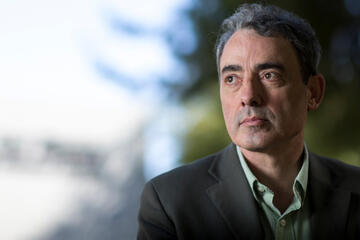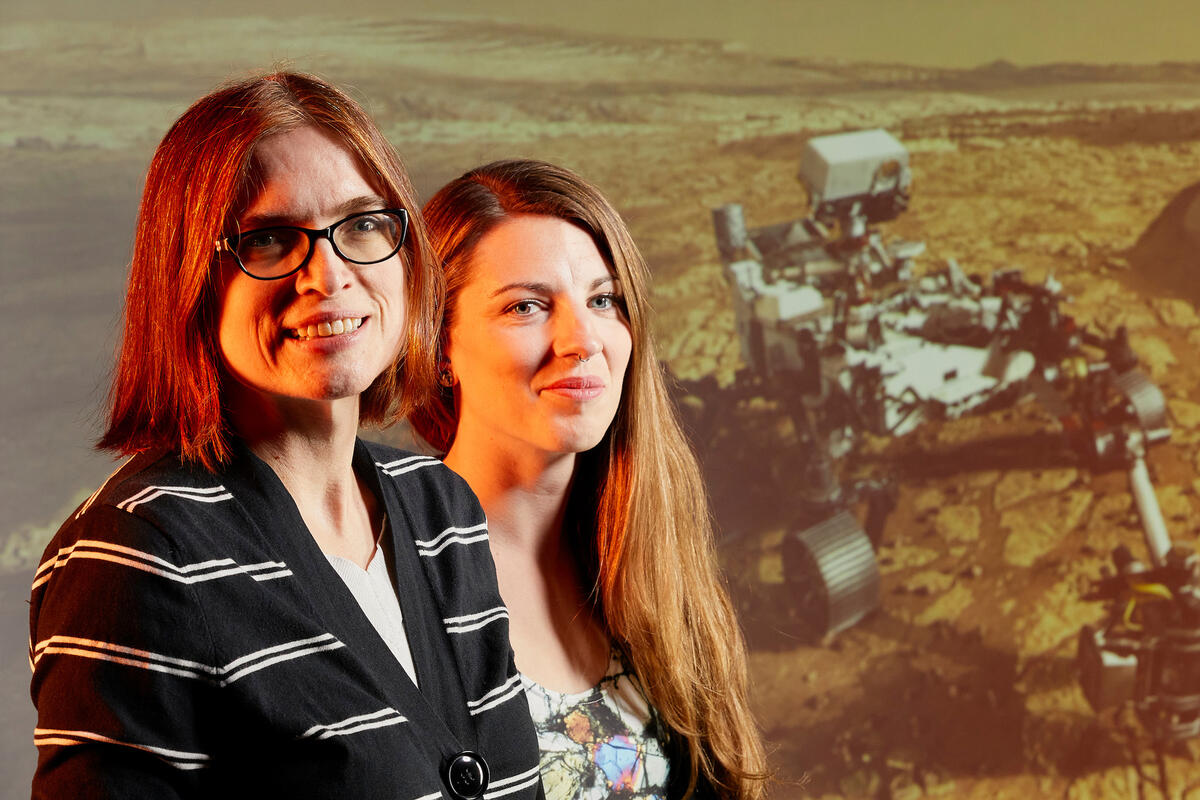When the Mars 2020 mission launches this summer, the rover will travel more than 100 million through space to reach Earth’s nearest neighbor. For two UNLV geoscientists, Mars is far more immediate – tangible, even. They’re part of a community of researchers at UNLV sharing their expertise with one another and the global scientific community to advance our understanding of the Red Planet.
It’s common for travelers to pocket a rock as a memento from their destination. The Mars Perseverence rover isn’t far off from its human counterparts in that regard (except it doesn’t need a passport or tickets to get there). After it lands on Mars in February 2021, the rover will collect and store rock samples from the 30-mile-wide Jezero Crater for return to Earth on a future mission.
Elisabeth “Libby” Hausrath, an associate professor of geoscience at UNLV, is on the team that will direct the rover’s collection efforts. She was chosen by NASA as one of just 10 scientists who will help select and cache Martian rock, soil, and related samples.
“I was so excited when I got the call — I jumped up and down,” Hausrath said. “I’ve been working on Mars data for a long time and have applied several times before. I couldn’t believe I had been accepted.”
- Chris Adcock, assistant research professor of geochemistry, studies phosphate mobility and transport on Mars.
- Aude Picard, assistant research professor in life sciences, researches microbial iron sulfide minerals as biosignatures for life on Mars.
- Oliver Tschauner, research professor of geoscience, has studied the possibility of water on Mars.
It was another Mars mission, the Mars Rover Exploration mission that launched in 2003, that first expanded Hausrath’s research into the interactions between rocks and water beyond our own planet. At the time, she was researching aqueous geochemistry as a doctoral student at Penn State University. When the Opportunity rover sent back evidence of past water on Mars, the data resembled the type Hausrath was collecting on Earth.
She and her advisor co-wrote a proposal that caught NASA’s attention. The agency not only funded the rest of Hausrath’s doctoral research into water/rock interactions and the implications for the geological history of Mars, but also then welcomed her as a postdoctoral fellow at the Johnson Space Center.
“On Earth, those interactions are important to study for lots of environmental reasons,” Hausrath said. “We need clean drinking water, and we depend on the soil for all of our food. In terms of studying Mars, water is essential for terrestrial life. If we look at environments that at one time had liquid water, then they also have the potential for past life.”
In fact, that’s one of the return sample team’s top priorities: to collect rocks that could contain past biosignatures.
“If there was life on Mars, there is evidence that we could see in labs back on Earth,” she said. “We also want samples that help us more broadly understand Mars, its past climate, and the internal magmatic processes that formed the planet’s igneous rock.”
Hausrath had a hand in shaping those very criteria. She served on the Returned Sample Science Board, which provided scientific input into the design and implementation of the Mars 2020 rover mission.
In preparation for the mission’s launch in July or August, the return sample team has run simulations of multiple collection sites.
“We’re shown an environment on Earth and we talk about what rocks we see, what potential they have for biosignatures, and where we would sample,” she said.
Team members will be on hand in Florida for the launch and then ready to spring into action once the rover starts sending data.
Until those cached rocks return to Earth — they’re slated for a 2031 mission — scientists must work with the material they have: Martian meteorites. Arya Udry, an assistant professor of geoscience at UNLV, studies Martian meteorites to better understand the planet’s magmatic processes and the evolution of the Martian interior.
As a child growing up in France, Udry dreamed of becoming an astronaut. When people told her she couldn’t do that, she turned to geology instead
“At 15, I decided I wanted to work on Martian meteorites,” Udry said. “I’d be able to actually touch Mars. (Now) I have pieces of Mars in my office, and I get to study them every day. How much more exciting does it get?”
According to NASA, more than 50,000 meteorites have been found on Earth; 99.8 percent come from asteroids. The remaining 0.2 percent is approximately an even split between Martian and lunar meteorites. Government-funded expeditions and for-profit hunters search for meteorites in deserts ranging from Africa to Antarctica. Udry borrows meteorites from NASA or the Smithsonian or buys them from reputable dealers.
UNLV currently has 24 Martian meteorites.
“What’s exciting is that our meteorites likely all come from the same location on Mars,” she said. “We don’t know exactly where that location is, but we know they come from the same volcanic system, so in this way we can study them as a suite of rocks in the same way you would terrestrial rocks.”
Udry analyzes the chemistry and structure of nakhlites and chassignites, two distinct but similar Martian rock types, to better understand their composition and location in the Martian crust. She recently earned a grant that funded a laser ablation system, which allows her to measure elements and isotopes in the meteorites in even smaller concentrations.
Like Hausrath, Udry is eager for data from the Mars 2020 rover, so she can continue her research into the puzzling presence of felsic rocks on Mars. On Earth, these rocks result from tectonic activity, which doesn’t occur on Mars.
“One of our big questions is: How similar is Mars to Earth? The more meteorites and rover data we have, the more we can tell how diverse the different types of rocks on both planets may be.”
When Udry and Hausrath have a Mars question that extends beyond their respective fields of expertise, they consult with one another and their fellow geoscience colleagues.
“I’m the volcanic rock expert, and Libby is an expert in low-temperature surface processes, so we collaborate,” Udry says. “The fact we all study something different about Mars is great. It enables us to study Mars as a whole and better understand the planet.”

A constellation of opportunities
UNLV’s partnership with Lockheed Martin is providing engineering students with not just real-world experience, but out-of-this-world experience. A team of undergraduates and graduates is performing quality control tests on components of NASA’s Orion deep-space capsule, which is designed to travel on the Artemis missions to the moon and, eventually, to Mars.
In the Materials Performance Lab, the team has tested the tensile strength (resistance of a material to break under tension) and other attributes of composite panels These specimens are made from the same material that will be used on the spacecraft but designated strictly for testing. They’ve coordinated and communicated with other quality team members spread out across the country.
“The students are interacting with some of the top quality experts in the industry,” said Brendan O’Toole, mechanical engineering professor and chair of the department of mechanical engineering.
The students also developed 3D-printed alternatives to the machined metal drill plates used by the hundreds during the assembly process. This cheaper, faster manufacturing method could potentially cut months off of assembly time.
“It’s easy to get caught up in the work,” O’Toole said. “But when you step back and look at the bigger picture, it’s super exciting to think we are part of the team that’s sending people to Mars and making it happen safer and quicker.”
The (vital) need for speed

En route to Mars, astronauts will face a number of health risks, including increased exposure to radiation from galactic cosmic rays. Francis Cucinotta, a professor in UNLV’s integrated health sciences department, recently published research showing that the cancer risk from cosmic rays to astronauts on a Mars mission is double the previous estimate.
“Cells directly damaged by the radiation send biochemical signals to their neighbor cells,” said Cucinotta, a former NASA scientist. “This non-targeted effect is a second way that you create these mutations that cause cancer.”
One way to reduce astronauts’ radiation exposure is to speed up the trip. Kimberley Gonzalez, a UNLV doctoral candidate in mechanical/nuclear engineering mentored by engineering professor William Culbreth, caught NASA’s attention with her work designing a uranium fission reactor for space travel.
She interned last summer on NASA’s pulsed fission fusion propulsion system project, which could potentially get crews to Mars in 30 to 60 days instead of the current estimate of six months.
“The time that is saved traveling in space,” Gonzalez says, “could potentially decrease health risks that astronauts face.”



